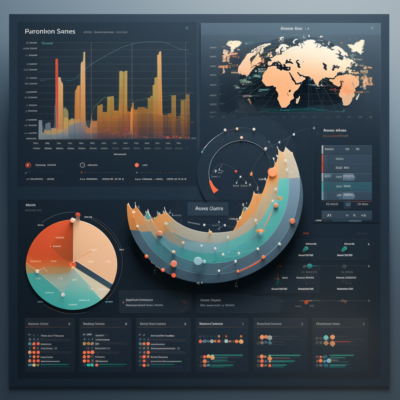
In the second installment of our blog series on organizing analytics, we’ll take a closer look at common paths that organizations follow over time as they mature and grow their analytical capabilities. This writing builds on the first article exploring fundamental goals and objectives of organizational structure, a new continuum-based approach to organizational models, and guidance determining where your organization falls on the continuum.

Organizing Analytics and Data Science Organization eBook
Formally and intentionally organizing your analytics teams is an integral part of any organization's analytics journey. Additionally, planning out how your company should eventually re-organize its analytics teams is also foundational to growing its capabilities and analytics maturity. Get tips from experts at IIA on how your team should be organized from the eBook below.
There are several common paths that organizations follow over time as they transition to advanced analytics and AI. Typically, these paths are not explicitly pursued as much as they naturally occur as analytical demand, success stories, and sophistication increase. However, this does not mean that organizations cannot learn by understanding these common paths, where they fall within them, and how they might accelerate their next steps along the path the company is on. IIA is not suggesting that these paths are the “correct” paths or the only paths; they are simply some of the most common paths we see taken.
As already discussed, organizational designs for analytics typically land upon a hybrid model because analytics requires a balance between centralized learning and distributed execution. However, there are different ways to get to that end state as well as cases where a different end state is more desirable. Let’s dive into four of the most common paths of organizational evolution.

Common Evolution Path 1: Functional to Centralized to Hybrid
In these situations, a company begins with a single, functionally based team. It may be within marketing, or risk management, or somewhere else. The team is a huge success and has large impacts on the home function. Other functions within the organization hear about this success and start to ask to tap into the team, which can lead to a consulting model where the home function “rents out” analytical resources to other functions to provide services. The team may stay housed within its initial functional unit but is eventually pulled into a central reporting role to reflect its increased span.
Over time, however, it is recognized that each business unit or function needs substantive and dedicated support. The need for corporate support and a unified strategy is also recognized. So, a hybrid model eventually evolves with a central corporate team coordinating efforts across the dispersed business unit teams. Once a CAO, CDAO, or CDO is hired, they take the helm within the central team and move the organization forward.
Common Evolution Path 2: Functional to Decentralized to Hybrid
In these situations, a company begins with a single, functionally based team. As in the prior path, it has substantive and highly visible success. However, instead of trying to borrow resources from the initial team, other business functions and units decide to mimic the model and add their own analytics and data science teams. This strategy, of course, quickly leads to a decentralized organization spread out across the company.
Over time, the lack of coordination, redundancy of effort, and lack of consistent strategy is recognized as a problem. This leads either to all teams being combined into a centralized organization or, more commonly, the addition of a central corporate team tasked with adding a layer of coordination and consistency across the dispersed groups. The central team might start without formal ownership of the dispersed teams, who may be encouraged to “be team players” and voluntarily facilitate the coordination efforts. Eventually, the central team is given official authority over the dispersed teams, which is often formalized with the hiring of a CAO, CDAO, or CDO to take the helm.
Common Evolution Path 3: Centralized to Hybrid
In these situations, a company decides to get into analytics by chartering an initial analytics and data science organization centrally. There are no functional or business unit teams. The centralized team shows success across different parts of the business and continues to grow over time. As the internal clients for the team get more sophisticated, they begin to want some dedicated support to help them better pursue key initiatives.
Just as with Path 1, some resources are pushed out to the various units to directly support them. Initially, these resources likely continue to report to the strong and established central team, but over time they may begin to report to the unit directly, with a mandate to coordinate with the central team. Of course, this is an evolution into a hybrid model and similarly supports a CAO, CDAO, or CDO coming in to take ownership of all analytical activities across the enterprise.
Common Evolution Path 4: Freeze at Centralized
In these situations, a company might start down any of the prior three paths. However, based on strong cultural and organizational precedents for having central control structures, the organization stops its evolution at a centralized structure and specifically does not take the step to a hybrid model. There are companies where this approach is quite effective and where trying to go hybrid will cause more resistance and difficulty than it is worth. Staying with a centralized model in these cases will allow the analytics and data science organization to blend in with other strategic parts of the organization and will allow it to adapt the company’s well-developed approach to managing and driving value from centralized teams. A CAO, CDAO, or CDO eventually steps in to take ownership of the team.
Drivers Pushing Companies Down These Paths
The drift toward hybrid structures happens in most cases for several reasons. First, if a company wants to differentiate itself in the marketplace through its analytical capabilities, it doesn’t make sense to manage all analytics locally within each business function or unit. Skilled and experienced analysts are a scarce and high-demand resource.
Next, the central component of the organization can deploy resources on the most important projects, including cross-functional and enterprise-wide projects that may be otherwise difficult to staff. If the enterprise outsources some analytics activities or relies extensively on external partners, those relationships are often best managed centrally to ensure consistency of pricing, legal terms, and IP protection.
Last, having a broad organization also facilitates recruitment, personal development, and a strong community because people have more opportunity to connect with and learn from one another. With a range of different opportunities throughout the company, all coordinated centrally, employees can have a variety of experiences over time while maintaining visibility within the overall organization to be considered as more senior positions become available.
As outlined in the previous section, some companies find success in sticking with a purely centralized team as opposed to moving to a hybrid model. This most often occurs when there is a corporate precedent and preference for having strong centralized support teams. It is also very common in smaller organizations who do not have sufficient scale to spread resources out further.
Navigating Your Organization’s Path
How aggressive can you be in terms of consolidating and coordinating your analytics and data science organization across the enterprise? If you’re starting with a functional or decentralized model, “dropping in” a new centralized team can send a strong and positive signal. Sometimes that same move backfires and causes a backlash because the business functions and units are concerned about losing their local control and they aren’t yet ready to trust the change being implemented.
The most sensible path is a deliberate, but gradual, migration plan for consolidating or coordinating groups, changing reporting lines, and layering on governance mechanisms as analytical capabilities and maturity grow. The best path will depend on each company’s culture, maturity, and precedents. Be sure to look at any organizational consolidation carefully from the stakeholders’ perspectives. Ask what’s in it for businesspeople and management, for the analytics professionals, and the enterprise at large.

Analytics Maturity Assessment
Find out how you can get in-depth diagnostic insights, recommendations, and benchmarking on your enterprise analytics maturity, your analytics organization capabilities, and the skills of your individual contributors.
Assessing Your Current State and Defining Your Next Move
It is very important to assess your current state if you are to define a path forward. IIA considers a detailed and objective assessment to be so important that we’ve spent years developing our own Analytics Maturity Assessment model. Regardless of how you decide to execute your own assessment, there are a range of critical questions to consider, some of which include:
- What is the current organizational model for analytics?
- What are the current capabilities of the organization and how broadly are they applied?
- What are the next application targets and business opportunities?
- How urgently does the enterprise need to build analytical capability?
- How important is it to generate and manage demand for analytics across the enterprise?
The feasibility of an organizational restructuring starts with the readiness and willingness of the people whose responsibilities or affiliations will change. There are also practical concerns including:
- Timing: There never seems to be a quiet time in which to make changes, and some organizations suffer from “change fatigue.”
- Funding: What are the transition costs and who will pay for them?
- Work Environment: If people are changing work locations or reporting structures, this requires change management.
Never assume that any structure will be “final.” Over time, it is likely that multiple changes will be required. It is even possible that an organization will change back and forth between the same models over time. This is a good thing if it is being done to best face the challenges and realities present at the time. Sales organizations, for example, sometimes swing between geographical and industry-focused structures as business conditions change. An analytics and data science organization swinging between different degrees of centralization and distribution of capabilities can be quite appropriate and effective if done at the right times and for the right reasons.
Wherever your company is on the maturity curve and whatever size the analytics organization is, the themes and options discussed within this series can help. To the extent that IIA can be of assistance during your journey, do let us know. In the meantime, we wish you success in evolving your own analytics and data science organizational structure in a way that enables not just the team’s success, but the success of your company as a whole.